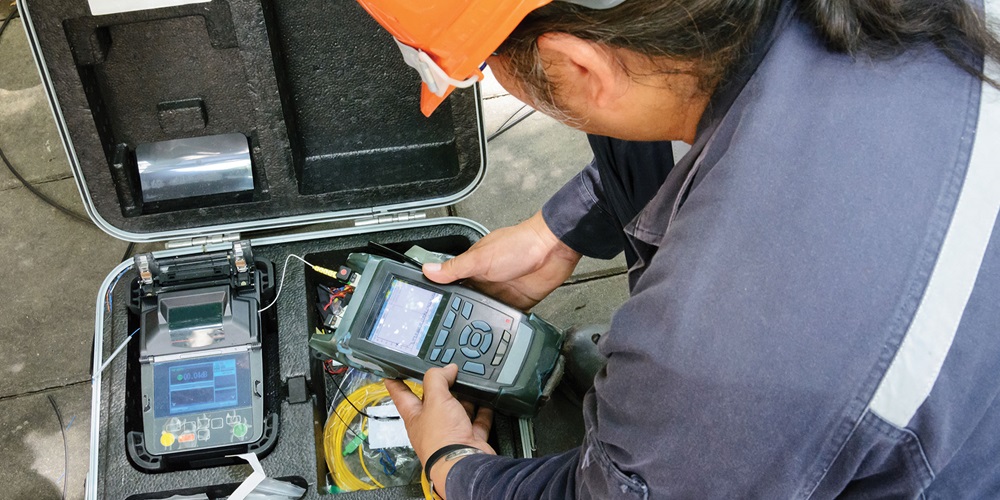A advanced optical fibre diameter analyser supports fibre manufacturing.
A advanced optical fibre diameter analyser supports fibre manufacturing.
Blog Article
Unveiling the Secret Use Optical Fiber Examining for Effective Information Transmission
In the realm of modern interaction, optical fibre testing emerges as an essential technique for maximizing data transmission. Understanding the multifaceted applications of optical fiber screening invites a deeper expedition into its pivotal role in forming the future of information interaction.

Importance of Optical Fibre Testing
The relevance of optical fibre testing can not be overstated, as it acts as an important element in making sure the reliability and efficiency of data transmission systems. In an age where high-speed interaction is vital, any shortages in fibre optics can bring about considerable information loss and decreased efficiency. As a result, rigorous screening protocols are necessary to validate the honesty and performance of optical cords.
Testing allows for the identification of problems such as micro-bends, macrobends, and splice losses that might prevent signal top quality. It provides insights into the overall depletion and bandwidth capabilities of the fibre, making certain that the network meets particular functional criteria. Normal screening not only enhances system performance yet additionally lengthens the life-span of the infrastructure by recognizing prospective issues prior to they rise into costly failings.

Kinds Of Optical Fibre Examinations
Different kinds of optical fibre examinations are carried out to guarantee the performance and dependability of fibre optic networks. These examinations can be categorized into a number of key kinds, each serving a particular purpose in analyzing the honesty of the fiber.
First, Optical Time Domain Name Reflectometry (OTDR) is a prominent examination that recognizes faults, mates, and adapters within the fibre. By sending pulses of light and examining the mirrored signals, service technicians can determine concerns along the fiber's length.
Second, insertion loss examinations assess the quantity of signal loss when light go through ports or splices, which is critical for maintaining network effectiveness.
Third, return loss examinations gauge the quantity of light mirrored back towards the source, offering insights into the high quality of links and possible resources of disturbance.
Additionally, continuity tests make sure that the fiber course is total, permitting professionals to confirm that the fibre is intact without any breaks. robotic vision.
Finally, visual fault locators use visible light to identify breaks or severe bends in the fibre, aiding in fast troubleshooting. Jointly, these examinations create a comprehensive approach to maintaining optimal performance in fiber optic go to website networks.

Applications in Network Upkeep
In modern-day telecoms, efficient network maintenance relies greatly on optical fiber screening to determine and remedy problems immediately. Normal screening makes sure that the network operates at optimal performance degrees, reducing downtime and boosting customer experience.
Among the primary applications of optical fibre testing in upkeep is the detection of mistakes, such as breaks, flexes, or improper links. Techniques like Optical Time Domain Name Reflectometry (OTDR) permit service technicians to locate these issues precisely and evaluate the quality of the fiber link. In addition, loss testing validates the integrity of the optical course, guaranteeing that signal depletion stays within appropriate limitations.
Routine upkeep testing additionally aids in preventative steps, identifying prospective problems prior to they escalate right into significant failings. This proactive approach can conserve organizations both time and funds. Throughout upgrades or growths, optical fiber testing makes certain that new installments integrate effortlessly with Continued existing framework.
Enhancing Data Transmission Reliability
Efficient network upkeep through optical fiber testing not only addresses immediate issues however additionally plays a considerable duty in enhancing information transmission reliability. By identifying mistakes, measuring signal loss, and examining the total condition of fiber optic cable televisions, screening guarantees that possible troubles are rectified prior to they rise into considerable disturbances.
Regular optical fibre screening, such as time-domain reflectometry (TDR) and optical time-domain reflectometry (OTDR), allows professionals to pinpoint the precise areas of breaks, bends, or connector problems within the network. This proactive approach not only minimizes downtime however additionally optimizes the efficiency of data transmission by making sure that the paths for signals are clear and working effectively.
In addition, screening help in confirming adherence to market requirements and specifications, which is important for preserving the stability of data flow. By making certain that each link fulfills needed thresholds for loss and quality, organizations can bolster their confidence in the integrity of their information networks.
Eventually, buying extensive optical fibre screening not just boosts information transmission dependability however also supports the long-term operational efficiency of interaction frameworks.
Future Trends in Fiber Screening
Arising modern technologies are positioned to reinvent fibre testing, leading the way for enhanced performance and precision in information transmission diagnostics (fibre testing equipment). As the need for faster web and higher transmission capacity remains to rise, the integration of sophisticated devices such as expert system (AI) and machine knowing (ML) is readied to transform standard fiber testing techniques. These innovations will allow anticipating maintenance and automated fault detection, substantially click this site lowering downtime and boosting network integrity
In addition, the adoption of Internet of Points (IoT) gadgets will facilitate real-time surveillance of fibre networks, enabling for immediate identification of efficiency problems. This change in the direction of proactive monitoring will lessen interruptions and optimize information circulation.
Furthermore, advancements in optical time-domain reflectometry (OTDR) and brand-new testing requirements will certainly enhance the precision of dimensions, making sure that information integrity is preserved throughout the transmission procedure. The advent of 5G technology likewise demands the development of much more advanced fiber screening strategies to support its high-speed requirements.
Final Thought
In verdict, optical fibre screening is necessary for preserving efficient information transmission within interaction networks. Regular screening not just ensures compliance with market requirements yet additionally helps with positive upkeep, inevitably adding to the long-term reliability and performance of fibre optic systems.
Report this page